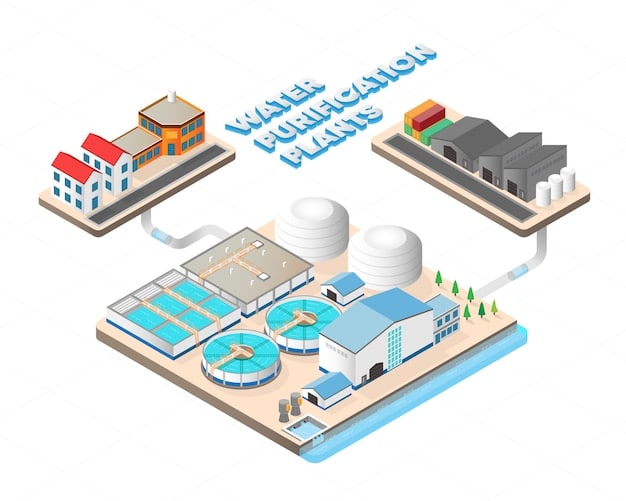PFAS Regulations: Impact on US Manufacturing & Water Treatment

The impending new regulations on PFAS chemicals in the US are set to significantly reshape manufacturing practices and water treatment protocols, demanding substantial investment in new technologies and stringent adherence to evolving environmental standards to safeguard public health and ecological integrity.
As the United States grapples with a growing awareness of per- and polyfluoroalkyl substances (PFAS) contamination, the regulatory landscape is shifting dramatically. Understanding how will the new regulations on PFAS chemicals affect US manufacturing and water treatment is crucial for industries, municipalities, and citizens alike. These “forever chemicals” pose significant health risks and environmental challenges, prompting federal and state authorities to enact stricter rules that promise to reshape industrial operations and public utility services across the nation.
Understanding PFAS: The “Forever Chemicals”
Per- and polyfluoroalkyl substances, or PFAS, are a group of synthetic chemicals that have been widely used in consumer products and industrial applications since the 1940s. Their unique properties, such as resistance to heat, water, and oil, made them valuable in everything from non-stick cookware and water-repellent fabrics to firefighting foams and industrial lubricants. However, their steadfast resistance to degradation means they persist indefinitely in the environment and accumulate in the human body, earning them the moniker “forever chemicals.”
The ubiquity of PFAS in modern life has led to widespread environmental contamination, impacting soil, air, and, most critically, water sources. Scientific studies have linked exposure to certain PFAS to a range of adverse health effects in humans, including increased cholesterol levels, liver damage, developmental effects, and certain cancers. These findings have intensified the urgency for regulatory action, pushing for comprehensive strategies to mitigate exposure and remediate contaminated sites.
Types and Sources of PFAS
The PFAS family encompasses thousands of individual chemicals, but two of the most studied and regulated are perfluorooctanoic acid (PFOA) and perfluorooctane sulfonic acid (PFOS). These chemicals were key ingredients in many products and processes for decades.
- Industrial Discharge: Manufacturing facilities that produce or use PFAS are significant point sources of contamination.
- Landfills: Products containing PFAS degrade in landfills, leaching chemicals into the surrounding environment.
- Firefighting Foams: Aqueous Film-Forming Foams (AFFF) used to extinguish petroleum fires are a major source of PFAS contamination, particularly around military bases and airports.
- Consumer Products: Everyday items like waterproof clothing, stain-resistant carpets, and packaging materials contribute to the overall PFAS burden.
The long-term movement of PFAS through various environmental pathways underscores the complex challenge they present, requiring multi-faceted approaches to control their spread and address legacy contamination. Identifying and tracking these sources are critical steps in developing effective regulatory frameworks.
Efforts to phase out certain long-chain PFAS chemicals have been underway for years, leading manufacturers to adopt alternative substances. However, newer, shorter-chain PFAS compounds, while potentially less bioaccumulative, still exhibit persistence and raise concerns about their environmental and health impacts. This constant evolution in chemical use makes regulation a dynamic and ongoing process.
Key New Regulations and Their Implications
The United States Environmental Protection Agency (EPA) is at the forefront of establishing new regulations to tackle the PFAS crisis. A pivotal development is the proposed National Primary Drinking Water Regulation (NPDWR) for six PFAS compounds: PFOA, PFOS, PFNA, PFHxS, PFBS, and GenX Chemicals. This proposal sets enforceable maximum contaminant levels (MCLs) and requires public water systems to monitor for these chemicals.
Beyond drinking water, the EPA is also designating PFOA and PFOS as hazardous substances under the Comprehensive Environmental Response, Compensation, and Liability Act (CERCLA), commonly known as Superfund. This designation has far-reaching implications, enabling the EPA to compel polluters to clean up contaminated sites and recover cleanup costs. It also impacts property transactions and development on affected lands.
Federal and State Initiatives
While the EPA leads federal efforts, many states have already enacted their own more stringent regulations, often preceding federal action. These state-level initiatives vary in scope but generally aim to:
- Establish State-Specific MCLs: Many states have set lower or more comprehensive drinking water standards than the initial federal proposals.
- Implement Bans and Restrictions: Some states have banned PFAS in certain products, such as food packaging or firefighting foam.
- Require Testing and Reporting: Increased mandates for industrial facilities and public water systems to test for and report PFAS levels.
The patchwork of state and federal regulations creates a complex compliance environment for businesses and water utilities operating across different jurisdictions. Harmonization of these regulations is a significant challenge, but the overall trend points towards increasingly strict controls. The unified approach aims to reduce overall PFAS exposure and prevent future contamination.
Moreover, the influx of funding from infrastructure bills specifically earmarked for water infrastructure upgrades and PFAS remediation will be essential in supporting compliance efforts. This financial impetus can help accelerate the adoption of necessary technologies and practices, easing the burden on smaller municipalities and businesses.
Impact on US Manufacturing
The implications of new PFAS regulations for the US manufacturing sector are vast and multifaceted. Industries that historically used PFAS as a core component of their processes or products face a significant overhaul, potentially requiring fundamental changes to their supply chains, product formulations, and waste management practices. This will demand substantial investment in research and development to find effective and safe alternatives.
For manufacturers, the immediate challenges include identifying and eliminating PFAS from their products and processes. This transition often involves re-engineering products, sourcing new materials, and upgrading production lines. The cost of these transformations can be substantial, especially for small and medium-sized enterprises (SMEs) that may lack the resources of larger corporations. Furthermore, the search for “safe” alternatives is complex, as new chemicals must be thoroughly vetted to ensure they do not present their own unforeseen environmental or health hazards.
Supply Chain Disruptions and Innovation
Manufacturers will need to carefully scrutinize their entire supply chain to identify and address PFAS contamination. This involves not only direct suppliers but also sub-suppliers and raw material providers. Companies might face supply chain disruptions as they transition away from PFAS-containing inputs, leading to potential delays or increased costs for some materials.
- Material Substitution: Companies must actively seek and validate PFAS-free alternatives for coatings, lubricants, and other applications.
- Process Re-engineering: Manufacturing processes themselves may need to be redesigned to eliminate or significantly reduce PFAS use and emissions.
- Increased R&D Investment: A greater focus on innovation to develop new materials and technologies that offer comparable performance without PFAS.
While challenging, these regulations also present an opportunity for innovation. Companies that successfully adapt and develop effective PFAS-free solutions can gain a competitive advantage and enhance their brand reputation. The push for safer chemistries drives a new wave of sustainable manufacturing practices, aligning with broader environmental, social, and governance (ESG) goals.

The regulatory shift also increases liability risks for manufacturers. Non-compliance can result in hefty fines, legal challenges, and reputational damage. The Superfund designation of PFOA and PFOS, in particular, means that manufacturers can be held responsible for cleanup costs associated with past contamination, even if their actions were legal at the time. This backward-looking liability adds another layer of complexity and financial risk.
Challenges and Opportunities for Water Treatment Systems
Public water treatment systems are on the front lines of protecting communities from PFAS contamination. New regulations, particularly the proposed MCLs in drinking water, present significant operational and financial challenges for these utilities. Many existing treatment plants are not equipped to effectively remove PFAS, necessitating substantial upgrades and the adoption of advanced treatment technologies.
Traditional water treatment methods, such as coagulation, flocculation, and conventional filtration, are generally ineffective at removing PFAS. These chemicals are highly soluble and resistant to degradation. Therefore, water utilities must invest in much more advanced and costly technologies to meet the new standards. The financial burden can be enormous, especially for smaller, rural water systems with limited budgets.
Advanced Treatment Technologies
To comply with the impending regulations, water treatment plants will increasingly rely on a suite of advanced technologies:
- Granular Activated Carbon (GAC): GAC filters are effective at adsorbing many PFAS compounds from water. However, the filters require regular replacement and proper disposal of the spent carbon, which is itself a hazardous waste.
- Ion Exchange Resins: Similar to GAC, ion exchange resins can effectively remove PFAS. They also require regeneration or disposal, presenting ongoing operational costs.
- High-Pressure Membranes (Reverse Osmosis/Nanofiltration): These membrane processes can remove a wide range of contaminants, including PFAS, but they are energy-intensive and produce concentrated waste streams that require careful management.
Implementing these technologies means complex engineering projects, significant capital expenditures, and increased operational costs due to energy consumption, specialized maintenance, and waste disposal. Utilities will likely need to pass some of these costs onto consumers through higher water rates, potentially impacting household budgets.
Alongside technological upgrades, increased monitoring and analytical capabilities are essential. Water systems will need to conduct regular testing to ensure compliance, requiring state-of-the-art laboratory equipment and trained personnel. The national rollout of these testing requirements will strain existing laboratory capacities and necessitate further investment in analytical infrastructure.
Despite the challenges, the focus on PFAS removal also presents opportunities for innovation in water treatment. Research into novel, more sustainable, and cost-effective removal technologies, such as advanced oxidation processes or electrochemical degradation, is accelerating. Utilities that proactively adopt and optimize these solutions can ensure public health protection while potentially fostering long-term operational efficiencies. Collaboration between research institutions, technology providers, and water utilities will be key in developing scalable solutions.
Economic Repercussions and Investment Opportunities
The new PFAS regulations, while driven by environmental and public health concerns, will inevitably create significant economic reverberations across the US economy. The costs associated with compliance—from manufacturing process overhauls to water infrastructure upgrades—will be substantial. However, these challenges also unlock considerable investment opportunities in new technologies, services, and sustainable practices.
Estimates for compliance costs vary widely but generally run into the billions of dollars annually. For manufacturers, these costs include R&D for alternatives, retooling production lines, managing hazardous waste, and potential remediation costs for historical contamination. Water utilities face expenses for new treatment technologies, increased monitoring, and infrastructure improvements. These expenditures will likely cascade through various sectors, affecting consumer prices for goods and services.

Emergence of New Markets
The push to eliminate PFAS and treat contaminated water sources is spurring the development of entirely new markets and expanding existing ones. This creates fertile ground for:
- Environmental Consulting and Engineering Firms: Specialized expertise in PFAS remediation, site assessment, and regulatory compliance will be in high demand.
- Advanced Materials Companies: Businesses developing PFAS-free alternatives for various industrial applications stand to gain significant market share.
- Water Technology Providers: Companies offering innovative solutions for PFAS detection and removal, including advanced filtration systems, will see increased sales.
- Waste Management Services: Specialized services for the safe collection, transportation, and disposal or destruction of PFAS-contaminated waste will become critical.
These emerging markets will drive job creation in specialized technical fields, fostering economic growth in the environmental sector. The transition away from PFAS can also improve environmental performance across industries, potentially leading to long-term gains in sustainability and corporate reputation.
Furthermore, government funding mechanisms, such as those included in recent infrastructure bills, are designed to alleviate some of the financial burdens on municipalities and provide incentives for private sector innovation. These investments signal a strong commitment to addressing PFAS contamination and can catalyze faster adoption of solutions, turning regulatory challenges into economic drivers.
Navigating Compliance and Future Outlook
For both US manufacturing and water treatment sectors, navigating the complex web of new PFAS regulations will require proactive strategies and a commitment to continuous adaptation. Compliance is not a static goal but an ongoing process, as scientific understanding of PFAS evolves and regulatory frameworks become more refined.
Manufacturers must establish robust internal systems for tracking chemical use, assessing risks, and ensuring supply chain transparency. This involves not only adhering to regulations but also anticipating future requirements and investing in inherently safer technologies. Embracing green chemistry principles and sustainable manufacturing practices will be key to long-term success and resilience.
Proactive Strategies for Industry and Utilities
To successfully navigate the new regulatory landscape, key strategies include:
- Comprehensive Audits: Industries should conduct thorough audits of their processes and products to identify all potential sources of PFAS contamination.
- Investment in R&D: Prioritize research and development into PFAS-free alternatives and advanced treatment methods.
- Cross-Sector Collaboration: Foster partnerships between industry, academia, and governmental agencies to share knowledge and develop solutions.
- Stakeholder Engagement: Engage with regulatory bodies, environmental groups, and communities to understand concerns and contribute to policy development.
For water utilities, this means developing long-term capital improvement plans that account for PFAS treatment upgrades, exploring diverse funding sources, and educating the public about water quality and safety. Building resilient water systems capable of adapting to emerging contaminants is paramount for protecting public health.
Looking ahead, the regulatory environment around PFAS is likely to intensify further. More chemicals within the PFAS family may come under scrutiny, and detection limits may become even lower as analytical capabilities improve. The emphasis will shift from mere compliance to proactive risk management and the complete elimination of these “forever chemicals” from the environment.
The journey to mitigate PFAS contamination is a marathon, not a sprint. It demands sustained effort, scientific innovation, and collaborative action from all stakeholders. While the initial impacts on US manufacturing and water treatment will be challenging, the ultimate outcome is a healthier environment and safer drinking water for communities across the nation.
| Key Point | Brief Description |
|---|---|
| 🧪 PFAS Challenge | “Forever chemicals” requiring broad regulatory action due to persistence & health risks. |
| ⚙️ Mfg. Impact | Demands product re-engineering, supply chain reform, R&D for PFAS-free alternatives. |
| 💧 Water Treatment | Requires significant investment in advanced technologies (GAC, RO) for removal. |
| 💰 Economic Shift | Creates new markets in environmental tech & consulting, driving innovation and jobs. |
Frequently Asked Questions About PFAS Regulations
▼
PFAS, or per- and polyfluoroalkyl substances, are a category of synthetic chemicals known for their water-repellent and stain-resistant properties. Used in numerous industrial and consumer products since the 1940s, they are often called “forever chemicals” because they do not degrade naturally in the environment and accumulate in living organisms, posing potential health risks across ecosystems and human populations.
▼
New PFAS regulations will likely increase manufacturing costs due to the need for research and development of alternatives, retooling production lines, and implementing new waste management protocols. Companies may also face significant expenses for remediating historical contamination sites, alongside potential legal liabilities and increased oversight in their supply chains to ensure compliance.
▼
Water treatment plants will need to adopt advanced technologies such as Granular Activated Carbon (GAC) filtration, ion exchange resins, and high-pressure membrane systems like reverse osmosis to effectively remove PFAS. These technologies require significant capital investment for installation and higher operational costs due to energy consumption, specialized maintenance, and the proper disposal of concentrated PFAS waste streams.
▼
Yes, significant economic opportunities are emerging in response to PFAS regulations. This includes growth in environmental consulting, engineering services for remediation, and the development of advanced materials. Companies specializing in PFAS detection, removal technologies, and sustainable chemical alternatives will see increased demand, fostering innovation and creating new jobs in the environmental technology sector.
▼
The timeline for new PFAS regulations to take full effect varies by specific rule and state. While some federal proposals, like the drinking water MCLs, are in the final stages, full implementation will require public water systems and industries several years to comply after finalization. Many states have already implemented their own stricter regulations, which are currently in effect, creating a complex and evolving regulatory landscape.
Conclusion
The new regulations on PFAS chemicals represent a pivotal moment for both US manufacturing and water treatment. While presenting formidable challenges in terms of compliance costs, technological adoption, and operational adjustments, they are essential steps toward safeguarding public health and environmental integrity. These regulations will drive profound innovation, foster the development of new sustainable technologies, and ultimately lead to a cleaner future for critical resources like drinking water. Navigating this evolving landscape demands proactive strategies, significant investment, and an unwavering commitment to health and environmental stewardship from all sectors involved.





